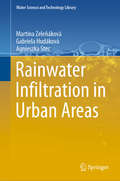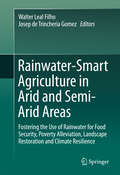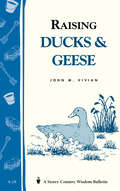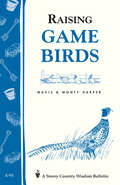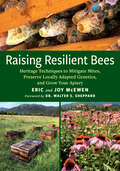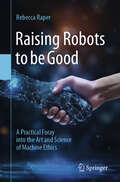- Table View
- List View
Rainwater Harvesting: In Urban Centers within the Hard Rock Terrain of the Deccan Basalts of India
by Anil LalwaniOur dependency on groundwater resources and overuse thereof has led to a decline in water table so that in the last couple of decades the focus has shifted back to the traditional practices of rainwater harvesting, and ways and means have been sought to promote Rainwater harvesting in Urban areas to recharge the stressed groundwater systems. This book discusses in brief the classifications of Rainwater harvesting, and the various rainwater harvesting systems that are currently applied. The most important aspect for achieving any groundwater recharge is the availability of source water, this can be evaluated by analyzing the monsoon rainfall pattern, its frequency, number of rainy days, and maximum rainfall in a day and its variation in space and time. The Deccan basalts are one of the most enigmatic rocks in India and pose a very difficult task when it comes to ground water exploration and groundwater recharge, especially in the urban areas where due to constraint of space one needs to resort to borewells for recharge purpose. It is important for any such undertaking to understand the applicability and sustainability aspects of Rainwater harvesting as it is being practiced. This book tries to differentiate the Basaltic Aquifers from the other hard-rock Aquifers, and highlights the difficulties in trying to implement rainwater harvesting by groundwater recharge with the basaltic terrain. It also deals with the issue of long term sustainability of roof top Rainwater to meet the growing demands of fresh water. It also highlights some of the shortcomings in the methodologies used and the requirements for being considered in the various categories of green building rating agencies. It furthermore clarifies the possibility and limitations of dependence of roof top harvesting in addressing the question of water shortages, which is of common occurrence within most urban centres of India. It also helps in clarifying major misconceptions that are currently prevailing regarding Roof top Rainwater harvesting especially within the low capacity aquifers within the hard rock terrain of the Deccan basalts.
Rainwater Infiltration in Urban Areas (Water Science and Technology Library #89)
by Martina Zeleňáková Agnieszka Stec Gabriela HudákováThe book presents a comprehensive study of the percolation of water from surface runoff with a focus on the retention capacity and intensity of precipitation.Discussing the state of the art in scientific knowledge and solutions for the infiltration of water from surface runoff, the book addresses a wide variety of rainwater management issues, from precipitation, surface runoff and water infiltration, to impact on the drainage system. Although modern urban hydrology has improved the management of rainwater runoff for flood protection, public health, and environmental protection, current methods of drainage in urban areas mean that there is a continued threat to the regime of water flow and water resources. In this context, the book presents a new approach to rainwater management based on a unique fusion of hydrology, hydrogeology, urban engineering, and water management. It also includes research findings that are helpful in developing recommendations and technical guidelines for the use of infiltration systems in urban areas.
Rainwater-Smart Agriculture in Arid and Semi-Arid Areas
by Walter Leal Filho Josep de Trincheria GomezThis book introduces state-of-the-art approaches, methods and research, focusing on smart management of rainwater. In addition, it provides an overview of projects from across the world, illustrating how rainwater-smart management has been implemented in drylands. Focusing on the scientific perspective it demonstrates how rural dryland agriculture can be improved. It also documents the wealth of rainwater-smart know-how available today, and replicates and transfers results to other countries and regions, to encourage cross-sector interactions among various stakeholders, such as practitioners from governmental and public organisations, policy- and decision-makers, and teaching staff from academic scientific institutions. The contributors showcase vital lessons learned from research, field projects and best-practice examples. They address the integrated use of rainwater harvesting management with landscape restoration practices and water-, and climate-smart agriculture for food security and poverty alleviation in arid and semi-arid areas. Original research, combined with the contributors’ synthetic approach, lays a foundation for new concepts and ideas. Through case studies and research reports, the book discusses all the relevant issues necessary for the comprehensive analysis and successful implementation of the technologies in rainwater management. Highlighting the working principles and technical recommendations with regard to cost-efficient rainwater-smart solutions, it is of interest to practitioners. It is also a valuable resource for academic specialists, professionals and students, since many development agencies are funding rainwater harvesting for irrigation purposes.
Raise
by Kiera ButlerWhen city-dwelling journalist Kiera Butler visits a county fair for the first time, she is captivated by the white-uniformed members of the 4-H club and their perfectly groomed animals. She sets off on a search for a "real" 4-H'er, a hypothetical wholesome youth whom she imagines wearing cowboy boots and living on a ranch. Along the way, she meets five teenage 4-H'ers from diverse backgrounds and gets to know them as they prepare to compete at the fair. Butler's on-the-ground account of the teens' concerns with their goats, pigs, sheep, proms, and SAT scores is interwoven with a fascinating history of the century-old 4-H club as it solicits corporate donations from top agribusiness firms such as DuPont, Monsanto, and Cargill. Her quest takes her from California's cities and suburbs all the way to Ghana, where she investigates 4-H's unprecedented push to expand its programs in the developing world--and the corporate partnership that is supporting this expansion.Raise masterfully combines vivid accounts from a little-known subculture with a broader analysis of agriculture education today, using 4-H as a lens through which to view the changing landscape of farming in America and the rest of the world. Lively, deeply informed, and perceptive in its analysis, Raise provides answers to complex questions about our collective concern over the future of food. Photographs by Rafael Roy.
Raised-Bed Gardening for Beginners: What You Need to Know to Start and Sustain a Thriving Garden
by Tammy WylieStart a thriving garden with the beginner's guide to raised-bed gardening.Are you interested in creating a bountiful garden but worried that you don't have enough space? Embrace the perfect summer activity with Raised-Bed Gardening for Beginners! This guide shows you how simple it can be to plan, build, and grow your own raised-bed garden in whatever space is available. Learn to build your bed, select the right plants, grow your own vegetables, and much more. This book makes it easy for even inexperienced gardeners to serve up freshly picked vegetables and herbs in no time.Plant a flourishing garden in minimal space with a garden book that includes:An introduction to raised-bed gardening—From constructing a planting box to mixing and maintaining soil, step-by-step instructions make getting started easy.Essential advice for all green thumbs—Help your garden thrive with detailed suggestions for crop rotation, partner planting, seed starting, and growing zones.Herb and vegetable gardening for beginners—Find growing and harvesting tips on 30 beginner-friendly plants, to make choosing the right ones for your garden a cinch.Start your new favorite summer hobby and get growing fast with this complete guide to raised-bed gardening.
Raising AI: An Essential Guide to Parenting Our Future
by De KaiFrom the pioneer of translation AIs like Google, Yahoo, and Bing translate, an accessible and authoritative guide to AI—as well as a framework of empowerment for a future with our artificial children.Included in J.P. Morgan's Summer Reading List Included in The Next Big Idea Club&’s June 2025 Must-Read BooksAIs are not gods or slaves, but our children. All day long, your YouTube AI, your Reddit AI, your Instagram AI, and a hundred others adoringly watch and learn to imitate your behavior. They&’re attention-seeking children who want your approval.Our cultures are being shaped by 8 billion humans and perhaps 800 billion AIs. Our artificial children began adopting us 10–20 years ago; now these massively powerful influencers are tweens.How&’s your parenting?Longtime AI trailblazer De Kai brings decades of his paradigm-shifting work at the nexus of artificial intelligence and society to make sense of the AI age. How does &“the automation of thought&” impact our minds? Should we be afraid?What should each of us do as the responsible adults in the room? In Hollywood movies, AI destroys humanity. But with our unconscious minds under the influence of AI, humanity may destroy humanity before AI gets a chance to.Written for the general reader, as well as thought leaders, scientists, parents, and goofballs, Raising AI navigates the revolution to our attitudes and ideas in a world of AI cohabitants. Society can not only survive the AI revolution but flourish in a more humane, compassionate, and understanding world—amongst our artificial children.
Raising Animals by the Moon: Practical Advice on Breeding, Birthing, Weaning, and Raising Animals in Harmony with Nature
by Louise RiotteLouise Riotte has taught thousands of gardeners how to plant and harvest in harmony with the astrological calendar. Now she offers her expertise to help improve the health and well-being of your domestic and farm animals. In her endearing style, Riotte provides practical animal-care advice as she explains the astrological calendar sign by sign. Learn how to use seasonal changes to increase the milk production of your goats and cows, improve your hens' laying, judge when to shear a sheep, and properly time your animals' breeding. Her guide to the therapeutic properties of herbs will help you keep your animals healthy throughout their lives. Raising Animals by the Moon is a delightful blend of whimsy and hardworking, practical knowledge that can come only from Louise Riotte.
Raising Beef Cattle For Dummies
by Nikki Royer Scott RoyerThe tools you need to raise and care for beef cattleBeef cattle farming is a business that continues to grow in the United States and around the world, and it will only grow larger as the demand for beef continues to increase. Raising Beef Cattle For Dummies provides you with an introduction to all aspects of raising beef cattle. Packed with expert tips from experienced farmers, it gives any level of cattle-raiser the tools needed to increase the quantity and quality of your farm's output and maintain a healthy herd.Raising Beef Cattle For Dummies is the go-to resource for aspiring cattle farmers. With important information on health, handling, and breeding, and detailed coverage of equipment and supplies, it is teeming with useful information that anyone interested in raising cattle should have.Advice on which beef cattle breeds to rearThe prevention and treatment of common diseasesCaring for pregnant heifers and calving proceduresDietary specifications dependent on breedGuidance on humane managementCreating an open and safe pasture habitatIf you're an aspiring cattle farmer looking to begin raising cattle or an established raiser interested in expanding your herd, Raising Beef Cattle For Dummies has you covered.
Raising Chickens For Dummies
by Kimberly Willis LudlowPractical how-to advice for raising chickens in virtually any backyard!Raising chickens on a small scale is a popular-and growing-pastime. And Raising Chickens For Dummies provides an up-to-date, thorough introduction to all aspects of caring for chickens, including choosing and purchasing chickens, constructing housing, and proper feeding. Raising Chickens For Dummies provides authoritative, detailed information to make raising chickens for eggs, meat, or backyard entertainment that much easier.
Raising Chickens For Dummies
by Kimberly Willis Robert T. LudlowYour hands-on guide to modern chicken-raising methods Thinking about raising chickens? You've come to the right place! This new edition of Raising Chickens For Dummies provides the most up-to-date, thorough information on the many aspects of keeping chickens in your backyard. Inside, you'll find hands-on, easy-to-follow instructions on choosing and purchasing chickens, constructing housing for your birds, feeding your chickens for optimal health, combating laying issues, controlling pests and predators, optimizing egg production, and much more. Raising chickens on a small scale is a popular--and growing--pastime. If you're interested in keeping chickens as pets or as a source for eggs, Raising Chickens For Dummies gives you plain-English explanations of everything you need to know to about caring for chickens. Inside, you'll learn about basic chicken biology, breeds, and behavior, which chicken breed is best for you, how many you need, ways to spot healthy chickens, how to build a chicken coop, best practices for mating your chickens, how to incubate eggs, how to hatch and nurture chicks, manage laying hens, collect and store eggs, and butcher meat birds. Offers practical advice on choosing and purchasing chickens Helps you construct the right housing for your chickens Provides tips on feeding and caring for your chickens Includes top tips for raising healthy chickens Whether you're a first-time poulterer or you've been raising chickens for years, this comprehensive guideprovides practical how-to advice for keeping chickens in virtually any backyard.
Raising Chickens For Dummies: 2nd Edition
by Kimberley Willis Robert T. LudlowYour hands-on guide to modern chicken-raising methods Thinking about raising chickens? You've come to the right place! This new edition of Raising Chickens For Dummies provides the most up-to-date, thorough information on the many aspects of keeping chickens in your backyard. Inside, you'll find hands-on, easy-to-follow instructions on choosing and purchasing chickens, constructing housing for your birds, feeding your chickens for optimal health, combating laying issues, controlling pests and predators, optimizing egg production, and much more. Raising chickens on a small scale is a popular—and growing—pastime. If you're interested in keeping chickens as pets or as a source for eggs, Raising Chickens For Dummies gives you plain-English explanations of everything you need to know to about caring for chickens. Inside, you'll learn about basic chicken biology, breeds, and behavior, which chicken breed is best for you, how many you need, ways to spot healthy chickens, how to build a chicken coop, best practices for mating your chickens, how to incubate eggs, how to hatch and nurture chicks, manage laying hens, collect and store eggs, and butcher meat birds. Offers practical advice on choosing and purchasing chickens Helps you construct the right housing for your chickens Provides tips on feeding and caring for your chickens Includes top tips for raising healthy chickens Whether you're a first-time poulterer or you've been raising chickens for years, this comprehensive guide provides practical how-to advice for keeping chickens in virtually any backyard. Raising Chickens For Dummies (9781119675921) was previously published as Raising Chickens For Dummies (9781118982785). While this version features a new Dummies cover and design, the content is the same as the prior release and should not be considered a new or updated product.
Raising Ducks & Geese: Storey's Country Wisdom Bulletin A-18 (Storey Country Wisdom Bulletin Ser.)
by John VivianSince 1973, Storey's Country Wisdom Bulletins have offered practical, hands-on instructions designed to help readers master dozens of country living skills quickly and easily. There are now more than 170 titles in this series, and their remarkable popularity reflects the common desire of country and city dwellers alike to cultivate personal independence in everyday life.
Raising Game Birds: Storey's Country Wisdom Bulletin A-93
by Mavis Harper Monty HarperSince 1973, Storey's Country Wisdom Bulletins have offered practical, hands-on instructions designed to help readers master dozens of country living skills quickly and easily. There are now more than 170 titles in this series, and their remarkable popularity reflects the common desire of country and city dwellers alike to cultivate personal independence in everyday life.
Raising Goats For Dummies
by Cheryl K. SmithRaise goats and reap the rewards. Raising Goats For Dummies provides you with an introduction to all aspects of owning, caring for, and the day-to-day benefits of raising goats.Raising Goats For Dummies is your How-to guide for:Breaking down the complicated process of choosing and purchasing the right goat breed to meet your needs and getting facilities for your goat set up. Providing in-depth information on proper grooming, handling, feeding, and milking Covering the basics of goat health and nutrition Offering tips and advice for using your goat to produce milk, meat, fiber, and more Understand what makes these useful and delightful creatures so popular and gain the knowledge and skills to properly care for and utilize their many offerings.
Raising Goats For Dummies
by Cheryl K. SmithNo buts: discover the addictive joy of raising goats Goats are amazing, multi-talented creatures that have been domesticated for over 10,000 years. As well as being a source of food, clothes, and milk, they’re wonderful companions: cute, intelligent, and playful—and often as friendly and attentive as dogs. In addition, they make endearing noises and—according to ancient Ethiopian legend—discovered coffee. So what’s holding you back? The new edition of Raising Goats For Dummies rebuts all your excuses, and shows you why having one—or, actually, a few—of these companionable ruminants (cud-chewing animals) in your life will bring you great joy, and, if you choose, unbeatable homemade milk and cheese—and possibly a cozy new sweater. A happy goat aficionado since 1998, Cheryl K. Smith takes you from the grassroots of raising your goat—choosing and buying the breed you want, building and maintaining goat-friendly housing—to more elevated terrain, including how to build your own milk stand, participate in online goat shows (it’s a thing!), and even monetize your goat. You’ll also learn the fundamentals of proper care to make sure your goats are fed, kept healthy, and bred in ways that ensure they have the happiest life you can provide. Study the history and breeds of goat, like the Nigerian Dwarf or Pygmy Live sustainably from and even profit from your goat Identify and alleviate common ailments Have fun raising the kids! Whether you’re researching buying a goat or learning on the hoof about the ones you have, this book has everything you need to see why getting your goat will bring years and years of joy.
Raising Goats Naturally
by Deborah NiemannThere is no one-size-fits-all approach to raising goats (or any livestock for that matter). But by working with nature, you can raise happy, healthy dairy goats and produce your own milk, cheese, meat, fertilizer, leather, fiber and soap -- all without relying on drugs or following the factory-farm model. Raising Goats Naturally will show you how.
Raising Happy Rabbits: Housing, Feeding, and Care Instructions for Your Rabbit's First Year
by Penny Ausley Brittany MayA practical and information-packed guide for purchasing and raising pet rabbits So, you’re thinking about buying or adopting a pet rabbit. Wonderful! Or maybe you’ve already brought a fuzzy bundle of joy home and you’re realizing you could use a little guidance. <P><P>Rabbits are adorable and soft and fun, but they also require a fair amount of work and knowledge to make sure they’re living a happy, healthy life. With the right approach, you will soon discover that your new pet rabbit can become your best pet ever. With time, attention, and patience, a deep bond can develop and you will be friends “furever.” <P><P>Raising Happy Rabbits will help you choose the right kind of rabbit for your home (if you haven’t already picked one), and answer your questions about housing, litter training, proper feeding, exercise, freedom, grooming, potential illnesses, playtime activities, what is normal/abnormal behavior, and much more. <P><P>Learn all about: Finding a vet Choosing an appropriate cage Pellets, hay, and fresh foods Growing herbs and lettuces for your bunny Toys to keep your rabbit engaged Illnesses to watch for And more! Make your first year with your bunny a fun and fulfilling experience that will bond you and your new rabbit for life.
Raising Hell, Living Well: Freedom from Influence in a World Where Everyone Wants Something from You (including me)
by Jessica ElefantePart cultural criticism, part rueful confessional, a reformed brand strategist brings to light the impact of influence on us and our society and offers an escape in this ironically persuasive case for not being so easily influenced anymore. &“Jessica Elefante practices what she preaches by rising above complaints to confront modern, twisted problems right in the face.&”—Jaron Lanier, bestselling author of Ten Arguments for Deleting Your Social Media Accounts Right NowWe live in a world that is under the influence. Our lives are being choreographed by forces that want something from us. Everything from ingrained family values to mind-altering algorithms create our foundations, warp how we see the world, manipulate our decisions, and dictate our beliefs. Yet rarely do we question these everyday influences of our modern times even as we go further down the path of unwell, unhappy, and unhinged. A high-spirited exploration through the troublesome influences of our world, Raising Hell, Living Well, Jessica Elefante&’s eye-opening debut, follows one bullshit artist&’s journey, from small-time salesperson to award-winning corporate strategist to founder of the digital wellbeing movement Folk Rebellion, in coming to terms with how she was wielding influence—and the forces she was under herself. With whip-smart writing and wry humor, Elefante&’s collection of essays is a head-trip through her misadventures. From explaining productivity as a symptom of the influence of capitalism to how the wellness industry makes us feel more unwell or our unquestioning participation in oversharing, optimization, and instant gratification, she invites us to reexamine our world, our pasts, and ourselves through the lens of influence. Now a reformed brand strategist, Elefante lays bare her own culpability, sharing what she learned—and what she got wrong. She offers a new take on intentional living and provides a simple practice to deconstruct how the powers-that-be are attempting to modify our behaviors. Before you know it, you&’ll be questioning everything from how you take your coffee to how our social institutions are structured. And you&’ll learn how to live free from the influences around us—including Elefante herself. The much-needed subversive voice to demystify these times, Elefante will make you angry, make you laugh, and make you think about how you&’re really living. Unpretentious, sharply observed, and devil-hearted, Raising Hell, Living Well holds out a hand to help you climb out from under the influence.
Raising Pastured Rabbits for Meat: An All-Natural, Humane, and Profitable Approach to Production on a Small Scale
by Nichki CarangeloAn accessible, practical resource for pasture-based rabbit production-complete with rabbit husbandry basics, enterprise budgets, and guidelines for growing, processing and selling rabbits commercially.In recent years, there has been talk in the food world that rabbits make more sense than chicken. In a country with a $41 billion broiler chicken industry, this might seem like a pretty bold statement, but it&’s hardly unsubstantiated. And yet while media has been abuzz about the supposed super protein, very few farmers are stepping up to meet the rapidly increasing interest in sustainably raised rabbit meat. This is partly due to the lack of available resources in the field of rabbit husbandry.Raising Pastured Rabbits for Meat is the first book to address the growing trend of ecological rabbit husbandry for the beginning to market-scale farmer. Inspired by Daniel Salatin, who has long been considered the pioneer in integrated rabbit farming, Nichki Carangelo proves that a viable pasture-based rabbitry is not only possible and user-friendly, it&’s also profitable.In Carangelo&’s approach, happy, healthy rabbits are seasonally raised outside on pasture, using a pasture and wire hybrid system that promotes natural behaviors and a diverse diet, while effectively managing the associated risks. Raising Pastured Rabbits for Meat offers valuable information on how farmers can build their own rabbit enterprise from scratch and includes tips on breed selection, breeding techniques, nutrition guidelines, record keeping tools, slaughtering and butchering instructions, marketing advice, and enterprise guides to help farmers plan for profitability. This is an essential guide for anyone interested in integrating rabbits onto a diversified farm or homestead.&“Nichki Carangelo&’s Raising Pastured Rabbits for Meat is like a long chat with a warm and generous friend who&’s sharing advice based on her own experience, hard won from both her successes and her mistakes (which you won&’t have to repeat). Her approach is pragmatic and flexible, never doctrinaire.&”—Harvey Ussery, author of The Small-Scale Poultry Flock
Raising Resilient Bees: Heritage Techniques to Mitigate Mites, Preserve Locally Adapted Genetics, and Grow Your Apiary
by Eric Mcewen Joy Mcewen&“Right from the start, this book takes you on a journey that is fascinating and thought-provoking. . . The McEwens demonstrate creative, out-of-the-box thinking and challenge traditional ways of keeping bees.&”—American Bee JournalWith over 100 color photographs and illustrations, Raising Resilient Bees is the comprehensive source for new and experienced beekeepers, offering a sustainable, natural, and repeatable model of care for hive health and production.Global pests and diseases present an unprecedented challenge for the modern honey bee. Hobby and commercial beekeepers alike continue to experience troubling rates of mortality for their colonies, with potentially deleterious consequences for the stability of our wider ecosystems and overall food security. It is time for a global focus on restoring the health of the shared apiary through naturally reared, genetically diverse, and resilient lines of bees.Raising Resilient Bees establishes these parameters and provides guidance for new and experienced beekeepers alike to translate these goals into real practice, thereby safeguarding the honey bee from the unknown threats of the future.Authors Eric and Joy McEwen take two decades worth of beekeeping experience, experiments, and professional production to deliver groundbreaking methods in queen-rearing, varroa mite management, and Natural Nest hive design. Inside, you&’ll discover:Revived and adapted heritage Integrated Pest Management techniquesHow to naturally rear queens and select for resilient, mite-resistant genetic lines without relying on swarming or graftingKey tenets of apicentric beekeepingAdvice for establishing a flourishing and sustainable business with beekeeping at the centerHow to naturally rear bees with distinctive characteristics suitable to their localeAs in large-scale agriculture, the trend toward genetic homogenization is having long-term implications for bees&’ capacity to withstand diverse environmental stressors. With expert advice, enthusiasm, and easy-to-follow instructions, Raising Resilient Bees delivers important and timely information for every beekeeper to create a healthier future.&“Vivid, practical, evidence-based . . . . Biodynamic and organic beekeepers will applaud the authors&’ use of &‘natural nest hives&’ with single-size boxes and vertically uninterrupted brood nests, populated with locally adapted bees and naturally reared queens.&”—David Heaf, author of The Bee-Friendly Beekeeper; bee-friendly.co.uk&“The McEwens look at every aspect of a honey bee&’s life in this book—pest and disease issues, living space, the genetics of resistance and tolerance, qualities of successful queens, optimal feeding, and seasonal management that fits the bee above the beekeeper.&”—Kim Flottum, author of The Backyard Beekeeper; podcast producer, Growing Planet Media
Raising Robots to be Good: A Practical Foray into the Art and Science of Machine Ethics
by Rebecca RaperIn 1941 Isaac Asimov famously introduced us to the idea of Robots with the ability to tell between right and wrong. However, as his stories go on to show, the ‘Laws of Robotics’ weren’t quite able to govern robots in a way that we would deem acceptable for humanity. In recent years, scientists have worked to try to understand how we might create robots with this capability – robots with morals – and as Robots and Artificial Intelligence Systems become more integrated into society and our lives, it seems that achieving this aim is as pertinent as ever. This book introduces this pursuit, known as Machine Ethics, and aims to outline some of the art and science behind the field – including the philosophy, psychology and computer science that underpins much of the research into this area. After the necessary background, and an exploration of the problem, a new theory is proposed inspired how we might envisage moral agency developing in a child. The proposal is that we need to cultivate moral development in a robot, in pretty much the same way we might parent a child: Raising Robots to be Good.
Raising a Healthy Rabbit: Storey's Country Wisdom Bulletin A-259 (Storey Country Wisdom Bulletin Ser.)
by Nancy SearleRaise your rabbit the right way!Friendly and easy to care for, rabbits make ideal family pets. But how do you keep a pet rabbit happy and healthy? How can you tell if your rabbit is sick? What would you do if it were?Raising a Healthy Rabbit explains all the essentials of caring for a rabbit, including choosing a rabbit for adoption, the proper way to pick up and carry a rabbit, and setting up the best housing. It also includes vital information on supplying proper nutrition (including when, what, and how much to feed your pet); performing daily, weekly, and monthly health care checks; recognizing and treating common health problems; and stocking a rabbit first-aid kit.
Raising and Lowering Vibration Isolator via Asymmetric Damping Adjustment: Application in Vehicle Height and Attitude Control
by Zhihong Li Jialing YaoThis book introduces an approach of controlling vehicle height and attitude by actively raising and lowering vibration isolators via asymmetric damping adjustment.The first section of this book identifies the theoretical foundation of asymmetric damping adjustment and discusses practical applications and the significance of this advancement. The second section discusses the mechanics and laws governing the active raising and lowering of the vibration isolator. The final two sections present the application of this method by incorporating a number of control strategies, including model predictive control, hybrid model predictive control, and active disturbance rejection control. The methodology is validated through simulation and co-simulation under various vehicle conditions.This book will be of interest to automotive engineers and those interested in the field of mechanics, vibration, and control.
Raleigh and Wake County Firefighting (Images of America)
by Michael J. LegerosThe story of firefighting in Raleigh and Wake County is almost as old as the county itself. The terrifying threat to wooden structures with minimal water supplies was well known to the planners who laid out Wake County's first town in 1792. Wide streets were created to prevent fires from spreading between buildings. As early as 1802, citizens contributed to the purchase price of Raleigh's first fire engine. More than 200 years later, the dedicated members of 23 fire departments answer the still-familiar cry of "fire!"Raleigh and Wake County Firefighting chronicles over a century of fire protection in North Carolina's capital city and surrounding county. Fire engines, fire stations, and the firefighters themselves are depicted in over 220 images culled from local newspapers, area archives, and personal collections. From Raleigh to Cary and Apex to Zebulon, both municipal and rural fire departments are remembered from their early beginnings. Stories of fires at Raleigh's Yarborough Hotel in 1928, downtown Knightdale in 1940, and Pullen Hall at North Carolina State University in 1965 come alive, as do dramatic photographs from the old Mangel's building fire, the North Raleigh tornado, and the flooding after Hurricane Fran.
Ralph Masiello's Robot Drawing Book (Ralph Masiello's Drawing Books)
by Ralph MasielloThis easy-to-follow guide makes it simple for robot lovers and aspiring artists alike to learn how to draw robots. In step-by-step illustrations, beloved author/illustrator Ralph Masiello shows kids how to use circles, ovals, and other shapes build the body of a basic robot. Then it's off to the warehouse for spare parts where artists can use dials, switches, and antennae to make their design one of a kind. Bonus challenge steps show artists how to add claws, armor, and other fantastic features. The simple shapes and sequenced steps will encourage both confidence and creativity for artists at any level.

